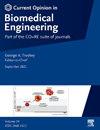Analysis of wireless powering modes for nanotransducer-mediated neuromodulation
IF 4.2
3区 工程技术
Q2 ENGINEERING, BIOMEDICAL
引用次数: 0
Abstract
Nanomaterials offer a promising approach for precise and minimally invasive modulation of neural activity versus traditional implants. This review explores recent advances in various nanotransducer systems that are powered by a remotely deliverable carrier signal (optical, mechanical, or magnetic) and output a neuromodulatory signal (optical, thermal, mechanical, or electrical). Key advantages of individual transduction methods have been highlighted, such as penetration to deeper brain regions, and potential for cell-specific targeting with or without genetic modification of the target tissue. Current challenges and advances are discussed in the context of considerations for clinical translation, which include optimizing transduction efficiency, reducing power requirements, and spatiotemporal stimulation control.

纳米传感器介导的神经调节无线供电模式分析
与传统植入物相比,纳米材料为精确和微创调节神经活动提供了一种很有前途的方法。本综述探讨了各种纳米换能器系统的最新进展,这些系统由可远程传递的载体信号(光学、机械或磁性)驱动,并输出神经调节信号(光学、热、机械或电)。个体转导方法的主要优势已经被强调,例如渗透到更深的大脑区域,以及有或没有对目标组织进行基因修饰的细胞特异性靶向的潜力。当前的挑战和进展在临床翻译考虑的背景下进行了讨论,包括优化转导效率,降低功率需求和时空刺激控制。
本文章由计算机程序翻译,如有差异,请以英文原文为准。
求助全文
约1分钟内获得全文
求助全文
来源期刊

Current Opinion in Biomedical Engineering
Medicine-Medicine (miscellaneous)
CiteScore
8.60
自引率
2.60%
发文量
59
 求助内容:
求助内容: 应助结果提醒方式:
应助结果提醒方式:


